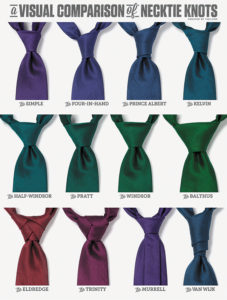 O.K., Fellows, might as well accept your fate. You will probably be given a tie for Father’s Day. Maybe you would like to know more about them. Learning about the different knots might be helpful.
O.K., Fellows, might as well accept your fate. You will probably be given a tie for Father’s Day. Maybe you would like to know more about them. Learning about the different knots might be helpful. Seeing necktie knots laid out side-by-side is the fastest way to grasp how they differ from one another. In order to play fair, Ties.com tied each knot using neckties of the same material, thickness and width (3 ½ inches). They also made sure to photograph them to scale. This way you can appreciate the unique characteristics of each knot and discern the differences between them.
Of the knots tied, the smallest is the Simple knot, sometimes known as the Oriental. If there is a way to tie a necktie smaller it hasn’t been found. The monstrous Balthus knot is the largest of the knots seen in the picture below but in theory you could make a knot even larger if you had a long enough necktie. Take note of the overall shape of each knot. The Windsor is almost a perfect triangle. The Four-in-Hand is much more narrow. The Prince Albert has a second fold that peeks out at the bottom. Some knots, like the Kelvin and Four-in-Hand lean noticeably to one side. The Trinity delivers a rounded silhouette while the Van Wijk is cylindrical and the longest of the knots.
Maybe you are a bow tie type of guy. The bow tie is a descendant of the knotted cravat. It was born from the need for neckwear that was easier to wear than the cravat and that would last throughout a more active day. By the end of the 19th century, the butterfly and batwing bow tie were commonplace. Black bow ties were worn with dinner jackets and white bow ties with evening tails. Today bow ties are mainly worn on formal occasions, however, in the past decade bow ties for everyday wear have seen a rise in popularity. A bow tie is perfect for any man who likes to stand out among his peers.
















Follow Us